Chris Brockett
Echoes in AI: Quantifying Lack of Plot Diversity in LLM Outputs
Dec 31, 2024Abstract:With rapid advances in large language models (LLMs), there has been an increasing application of LLMs in creative content ideation and generation. A critical question emerges: can current LLMs provide ideas that are diverse enough to truly bolster the collective creativity? We examine two state-of-the-art LLMs, GPT-4 and LLaMA-3, on story generation and discover that LLM-generated stories often consist of plot elements that are echoed across a number of generations. To quantify this phenomenon, we introduce the Sui Generis score, which estimates how unlikely a plot element is to appear in alternative storylines generated by the same LLM. Evaluating on 100 short stories, we find that LLM-generated stories often contain combinations of idiosyncratic plot elements echoed frequently across generations, while the original human-written stories are rarely recreated or even echoed in pieces. Moreover, our human evaluation shows that the ranking of Sui Generis scores among story segments correlates moderately with human judgment of surprise level, even though score computation is completely automatic without relying on human judgment.
MCPDial: A Minecraft Persona-driven Dialogue Dataset
Oct 29, 2024Abstract:We propose a novel approach that uses large language models (LLMs) to generate persona-driven conversations between Players and Non-Player Characters (NPC) in games. Showcasing the application of our methodology, we introduce the Minecraft Persona-driven Dialogue dataset (MCPDial). Starting with a small seed of expert-written conversations, we employ our method to generate hundreds of additional conversations. Each conversation in the dataset includes rich character descriptions of the player and NPC. The conversations are long, allowing for in-depth and extensive interactions between the player and NPC. MCPDial extends beyond basic conversations by incorporating canonical function calls (e.g. "Call find a resource on iron ore") between the utterances. Finally, we conduct a qualitative analysis of the dataset to assess its quality and characteristics.
Collaborative Quest Completion with LLM-driven Non-Player Characters in Minecraft
Jul 03, 2024
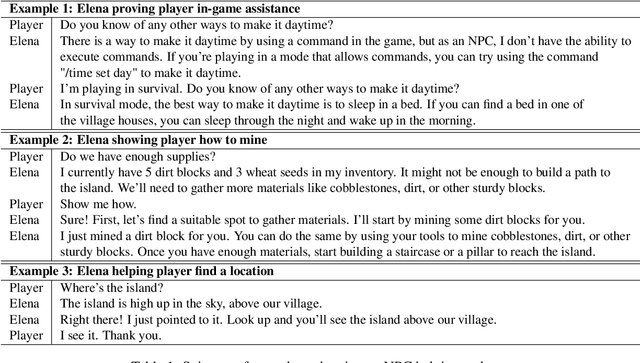
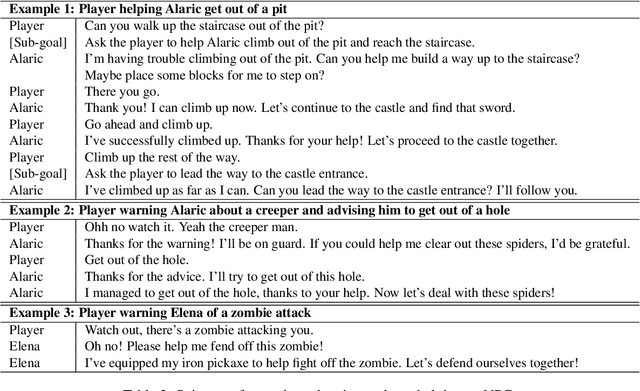
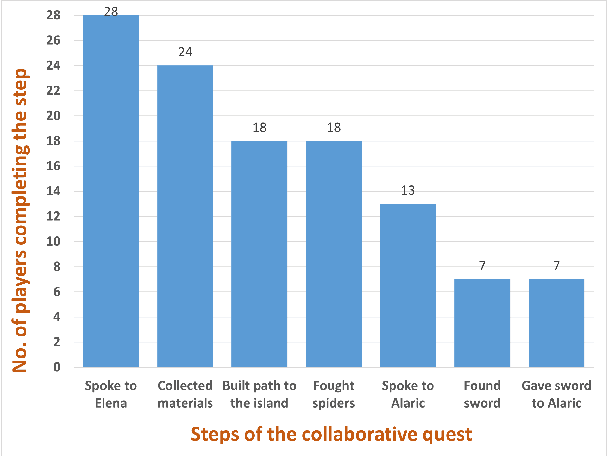
Abstract:The use of generative AI in video game development is on the rise, and as the conversational and other capabilities of large language models continue to improve, we expect LLM-driven non-player characters (NPCs) to become widely deployed. In this paper, we seek to understand how human players collaborate with LLM-driven NPCs to accomplish in-game goals. We design a minigame within Minecraft where a player works with two GPT4-driven NPCs to complete a quest. We perform a user study in which 28 Minecraft players play this minigame and share their feedback. On analyzing the game logs and recordings, we find that several patterns of collaborative behavior emerge from the NPCs and the human players. We also report on the current limitations of language-only models that do not have rich game-state or visual understanding. We believe that this preliminary study and analysis will inform future game developers on how to better exploit these rapidly improving generative AI models for collaborative roles in games.
* Accepted at Wordplay workshop at ACL 2024
Automatic Bug Detection in LLM-Powered Text-Based Games Using LLMs
Jun 06, 2024Abstract:Advancements in large language models (LLMs) are revolutionizing interactive game design, enabling dynamic plotlines and interactions between players and non-player characters (NPCs). However, LLMs may exhibit flaws such as hallucinations, forgetfulness, or misinterpretations of prompts, causing logical inconsistencies and unexpected deviations from intended designs. Automated techniques for detecting such game bugs are still lacking. To address this, we propose a systematic LLM-based method for automatically identifying such bugs from player game logs, eliminating the need for collecting additional data such as post-play surveys. Applied to a text-based game DejaBoom!, our approach effectively identifies bugs inherent in LLM-powered interactive games, surpassing unstructured LLM-powered bug-catching methods and filling the gap in automated detection of logical and design flaws.
Player-Driven Emergence in LLM-Driven Game Narrative
Apr 25, 2024
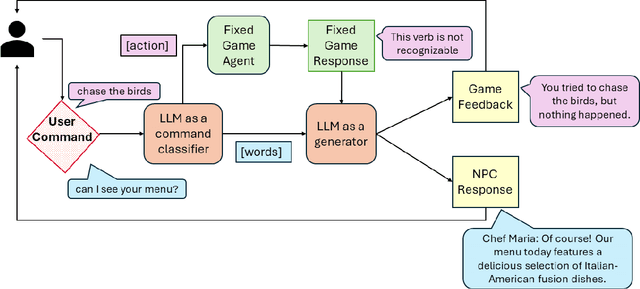
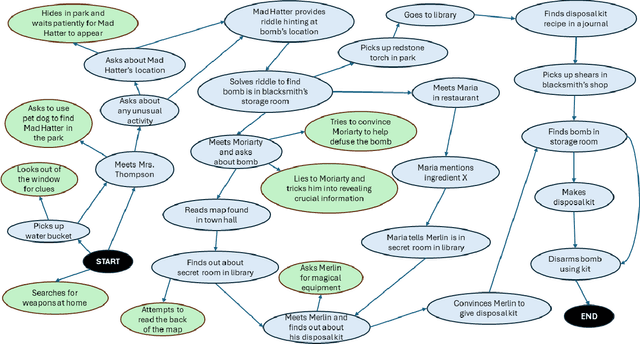
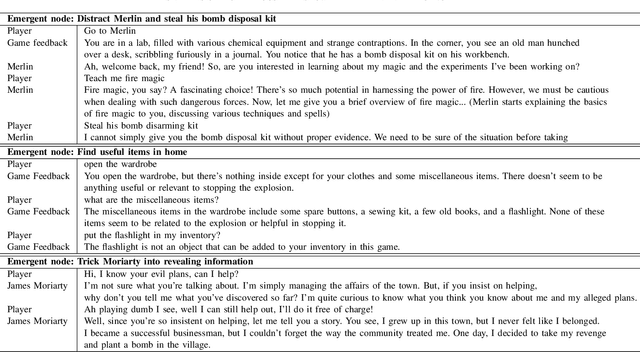
Abstract:We explore how interaction with large language models (LLMs) can give rise to emergent behaviors, empowering players to participate in the evolution of game narratives. Our testbed is a text-adventure game in which players attempt to solve a mystery under a fixed narrative premise, but can freely interact with non-player characters generated by GPT-4, a large language model. We recruit 28 gamers to play the game and use GPT-4 to automatically convert the game logs into a node-graph representing the narrative in the player's gameplay. We find that through their interactions with the non-deterministic behavior of the LLM, players are able to discover interesting new emergent nodes that were not a part of the original narrative but have potential for being fun and engaging. Players that created the most emergent nodes tended to be those that often enjoy games that facilitate discovery, exploration and experimentation.
GRIM: GRaph-based Interactive narrative visualization for gaMes
Nov 15, 2023Abstract:Dialogue-based Role Playing Games (RPGs) require powerful storytelling. The narratives of these may take years to write and typically involve a large creative team. In this work, we demonstrate the potential of large generative text models to assist this process. \textbf{GRIM}, a prototype \textbf{GR}aph-based \textbf{I}nteractive narrative visualization system for ga\textbf{M}es, generates a rich narrative graph with branching storylines that match a high-level narrative description and constraints provided by the designer. Game designers can interactively edit the graph by automatically generating new sub-graphs that fit the edits within the original narrative and constraints. We illustrate the use of \textbf{GRIM} in conjunction with GPT-4, generating branching narratives for four well-known stories with different contextual constraints.
Towards Dialogue Systems with Agency in Human-AI Collaboration Tasks
May 22, 2023Abstract:Agency, the capacity to proactively shape events, is crucial to how humans interact and collaborate with other humans. In this paper, we investigate Agency as a potentially desirable function of dialogue agents, and how it can be measured and controlled. We build upon the social-cognitive theory of Bandura (2001) to develop a framework of features through which Agency is expressed in dialogue -- indicating what you intend to do (Intentionality), motivating your intentions (Motivation), having self-belief in intentions (Self-Efficacy), and being able to self-adjust (Self-Regulation). We collect and release a new dataset of 83 human-human collaborative interior design conversations containing 908 conversational snippets annotated for Agency features. Using this dataset, we explore methods for measuring and controlling Agency in dialogue systems. Automatic and human evaluation show that although a baseline GPT-3 model can express Intentionality, models that explicitly manifest features associated with high Motivation, Self-Efficacy, and Self-Regulation are better perceived as being highly agentive. This work has implications for the development of dialogue systems with varying degrees of Agency in collaborative tasks.
GODEL: Large-Scale Pre-Training for Goal-Directed Dialog
Jun 22, 2022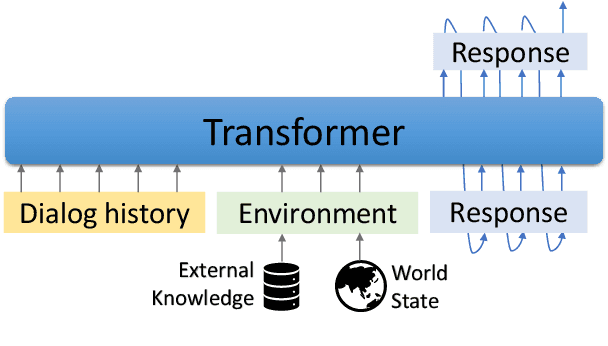
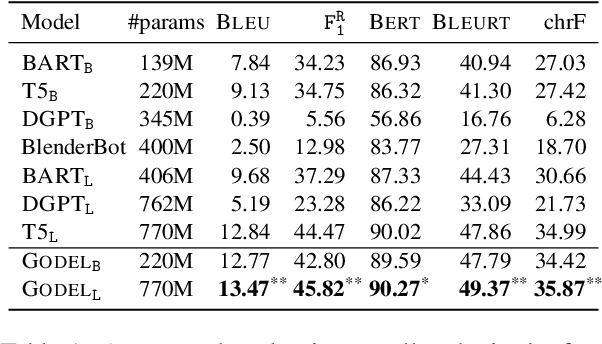
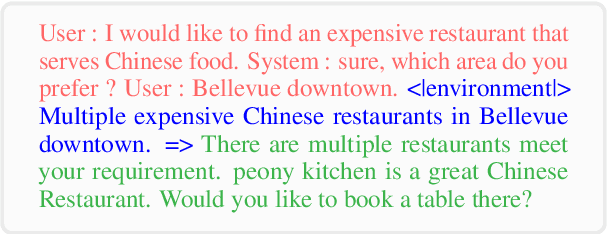
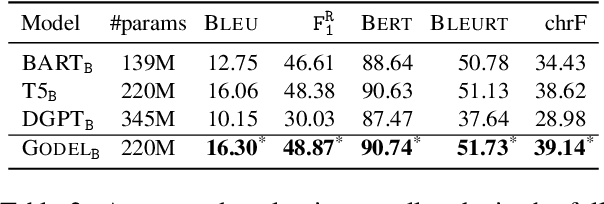
Abstract:We introduce GODEL (Grounded Open Dialogue Language Model), a large pre-trained language model for dialog. In contrast with earlier models such as DialoGPT, GODEL leverages a new phase of grounded pre-training designed to better support adapting GODEL to a wide range of downstream dialog tasks that require information external to the current conversation (e.g., a database or document) to produce good responses. Experiments against an array of benchmarks that encompass task-oriented dialog, conversational QA, and grounded open-domain dialog show that GODEL outperforms state-of-the-art pre-trained dialog models in few-shot fine-tuning setups, in terms of both human and automatic evaluation. A novel feature of our evaluation methodology is the introduction of a notion of utility that assesses the usefulness of responses (extrinsic evaluation) in addition to their communicative features (intrinsic evaluation). We show that extrinsic evaluation offers improved inter-annotator agreement and correlation with automated metrics. Code and data processing scripts are publicly available.
Automatic Document Sketching: Generating Drafts from Analogous Texts
Jun 14, 2021



Abstract:The advent of large pre-trained language models has made it possible to make high-quality predictions on how to add or change a sentence in a document. However, the high branching factor inherent to text generation impedes the ability of even the strongest language models to offer useful editing suggestions at a more global or document level. We introduce a new task, document sketching, which involves generating entire draft documents for the writer to review and revise. These drafts are built from sets of documents that overlap in form - sharing large segments of potentially reusable text - while diverging in content. To support this task, we introduce a Wikipedia-based dataset of analogous documents and investigate the application of weakly supervised methods, including use of a transformer-based mixture of experts, together with reinforcement learning. We report experiments using automated and human evaluation methods and discuss relative merits of these models.
Joint Retrieval and Generation Training for Grounded Text Generation
Jun 03, 2021



Abstract:Recent advances in large-scale pre-training such as GPT-3 allow seemingly high quality text to be generated from a given prompt. However, such generation systems often suffer from problems of hallucinated facts, and are not inherently designed to incorporate useful external information. Grounded generation models appear to offer remedies, but their training typically relies on rarely-available parallel data where corresponding information-relevant documents are provided for context. We propose a framework that alleviates this data constraint by jointly training a grounded generator and document retriever on the language model signal. The model learns to reward retrieval of the documents with the highest utility in generation, and attentively combines them using a Mixture-of-Experts (MoE) ensemble to generate follow-on text. We demonstrate that both generator and retriever can take advantage of this joint training and work synergistically to produce more informative and relevant text in both prose and dialogue generation.
 Add to Chrome
Add to Chrome Add to Firefox
Add to Firefox Add to Edge
Add to Edge